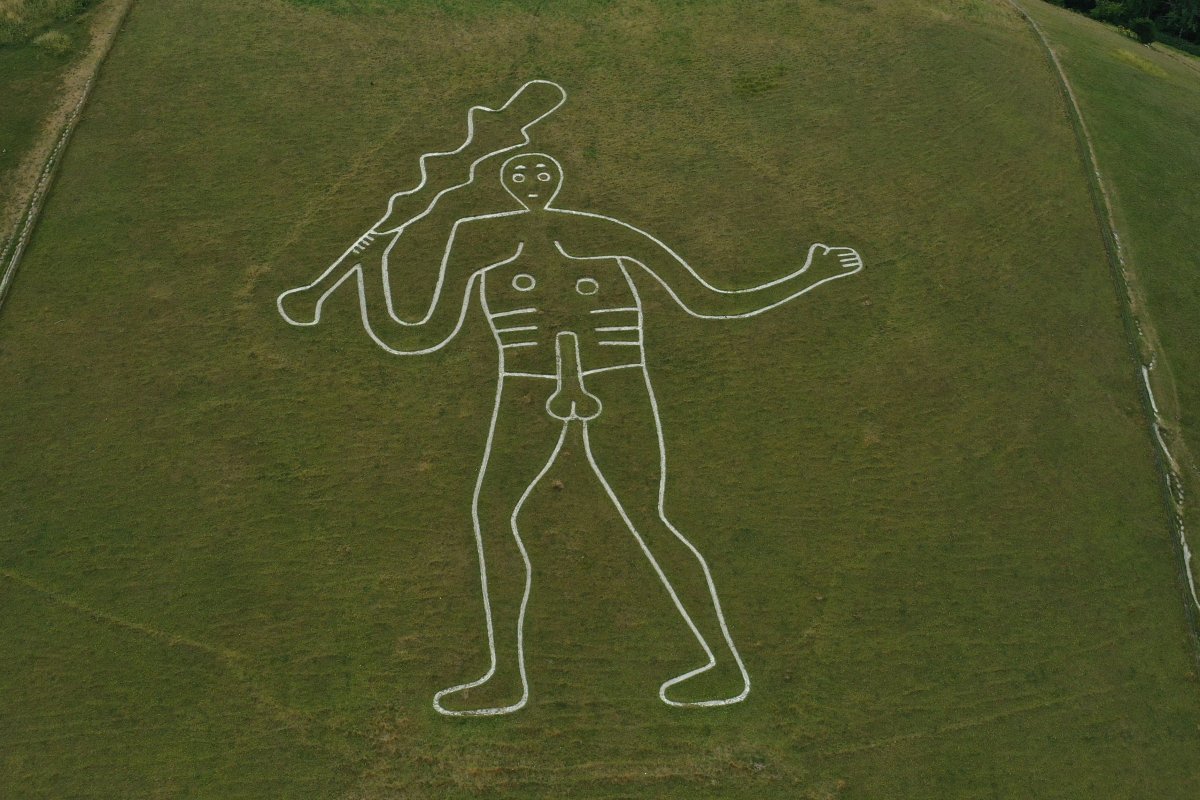A giant naked figure carved centuries ago into an English hillside represents the classical hero Hercules, a study has suggested—and may have aided armies in the medieval period.
Known as the Cerne Giant, the massive figure, which stands almost 200 feet high, depicts a naked man brandishing a club in his right hand, with his left arm outstretched.
His bald head is shaped like a tear-drop and contains facial features, while his torso depicts an erect penis, nipples, ribs, a belt and a belly button.
The figure is carved into the chalk bedrock of a hillside above the village of Cerne Abbas in the county of Dorset in southwest England.

The question of when the giant was carved has been debated for centuries, with most experts thinking it had been created in prehistoric times. Other possibilities that have been suggested include the period when Britain was ruled by ancient Rome (A.D. 43-410) or even the 17th century.
But with a lack of conclusive evidence, a team of researchers began work to date the monument in the spring of 2020.
These investigations revealed that the figure was cut in the early Middle Ages (also known as the medieval period) some time between A.D. 700 and A.D. 1110.
In light of these findings, researchers Helen Gittos and Tom Morcom—of the University of Oxford in the United Kingdom and the University of Oslo in Norway, respectively—decided to conduct their own study of the giant to shed light on its origins.
Gittos told Newsweek that the dating results, announced in 2022, were "really startling."
"I grew up near Cerne and so I took it as a bit of a personal challenge: how, as an early medieval historian, could I explain this?" she said.
While the dating work had revealed insights into the age of the figure, the reason why it was created remained something of a mystery.
In their study published in Speculum, the journal of the Medieval Academy of America, Gittos and Morcom propose an explanation for when and why the figure was originally cut. They argue that the giant was created as a depiction of Hercules (also known as Heracles)—a demi-god in Greco-Roman mythology famous for his strength and far-ranging adventures. He was often depicted with a bow but also, frequently, a club.
The study revealed that the characteristics of the figure match those seen in depictions of Hercules—a complex, flawed hero who was both revered and reviled. There was a spike in interest in Hercules in the ninth century and early 10th century, which is when the Cerne Giant was probably carved, Gittos and Morcom propose in the study.
"People had identified him as Hercules before but there has still remained a lot of skepticism about it," Gittos said. "One oddity is that it is very unusual for Hercules to be depicted with an upstanding phallus but there are some examples of this from Roman Britain and so we think that the inspiration for this precise iconography came from a Romano-British image."
But why was this image of Hercules carved into a hillside? It is not possible to determine precisely who commissioned the giant. But the authors suggest its location makes "good sense" as a special meeting place, possibly a mustering (or rallying) point, for an army of the West Saxons. The Saxons were one of the main Germanic peoples, alongside the Angles, who settled in lowland Britain after the period of Roman occupation ended.
By at least the 10th century, the Cerne estate was under the control of a high-status West Saxon official, known as an ealdorman. The location of the giant, on a spur jutting out from a ridge with impressive views and proximity to major routeways, is characteristic of a special type of Anglo-Saxon meeting place.
At the time, Dorset was being attacked by Viking armies. Taking this historical context and the giant's location into account, as well as the fact there was access to copious amounts of fresh water and supplies from the local estate, the giant would have been an ideal mustering point for West Saxon armies, according to the researchers.
"Cutting a chalk figure of Hercules as fighting warrior, with club poised to strike, would have served as a fine rallying point, a backdrop for a call to arms, a sermon in chalk—and, perhaps, as something with which to keep a gathering army busy," the authors wrote in the study.
"The idea that a special assembly site could be marked by such a monumental image is spectacular—and it raises more questions about other chalk figures that survive in the British landscape, their antiquity and purpose," Gittos told Newsweek.
By the 11th century, however, monks worshipping in a monastery founded close to the giant had reinterpreted the figure as an image of their patron saint, Eadwold. This was a convenient way of erasing Hercules and proclaiming the monastery's rights to the saint's relics, the authors suggest.
The researchers came to this conclusion after connecting the giant with a little-known and overlooked text detailing the life of Saint Eadwold, which was commissioned by the monks of Cerne in the 1060s or 1070s.
"This, we argue, describes the giant and is by far the earliest written reference to the giant by several hundred years," Gittos said.
Imagining the giant as the saint is just one of the many way ways that the figure has been interpreted over the centuries, a practice that continues into the present.
Uncommon Knowledge
Newsweek is committed to challenging conventional wisdom and finding connections in the search for common ground.
Newsweek is committed to challenging conventional wisdom and finding connections in the search for common ground.
About the writer
Aristos is a Newsweek science reporter with the London, U.K., bureau. He reports on science and health topics, including; animal, ... Read more
To read how Newsweek uses AI as a newsroom tool, Click here.






